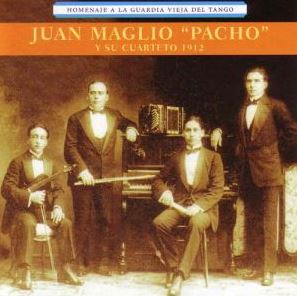I was fascinated to learn the story of Juan Maglio “Pacho”, one of the most important figures in Tango music, and one of the first practitioners of the Bandoneón in Argentina.
How did the son of a middle-class Argentine Italian immigrant with a funny nickname help shape Tango music in the early 1900’s closer to the music we know today? “Pacho” became such a successful recording artist that his nickname became synonymous in Argentina to the music record or disc.
Juan Felix Maglio (his full name) is credited to have linked the fate of this German instrument to Argentine Tango, and therefore changing the fate of this Latin music genre.
As a kid, one of the many mischiefs Maglio used to do was to take his father’s bandoneón and play it in hiding. Mr. Pantaleon Maglio didn’t mind this too much, but because of Juan’s behavior, he nicknamed him “Pazzo”, which means “mad” in Italian. Juan Maglio’s playmates could not pronounce correctly that word, so they uttered “pacho” instead.
The Bandoneón and the Orquesta Típica Criolla
The bandoneón is an accordion-type German instrument (some say it was actually invented in France) that was used in Germany as a cheap substitute to the church organ in poor villages that couldn’t afford an organ. The bandoneón arrived in Argentina with the Germans that were part of a massive European immigration which occurred around the turn of the 20th century.

Italians were also among the immigrants who came to Argentina around this time, and they brought with them a more lyrical style of playing the violin, with the melodic influence of Neapolitan song which surely helped give Tango it’s characteristically melodic beauty.
When Pacho was still a kid, his Italian father probably owned one of the very few bandoneons in existence in Argentina at the time. He also probably played the bandoneón with the Italian melodic influence, which surely attracted Pacho’s attention.
Juan Maglio “Pacho” grew learning all aspects of playing the bandoneón , progressing from the 13-voiced instrument to eventually dominating the 75-voiced one. At the age of 19 he debuted in café El Vasco with a trio formed of a violin, a guitar, and his bandoneón. But it wasn’t until 4 years later when he arrived at the format that would shape his music and Tango for years to come, when in 1903 he formed a quartet by adding a flute to his line-up.
Keep in mind that at the turn of the 20th century Tango remained music that was played mostly by singers accompanied with guitars or a piano, and groups formed with a violin, guitar, and flute, as Tango was the music of the poor and was therefore played with affordable portable instruments.
So when in 1912 Columbia invited Pacho to record with what by then had become a very popular Tango quartet in Argentina, he named his quartet the Orquesta Típica Criolla Juan Maglio “Pacho”.
Pacho’s Tango Recording Success
Pacho’s Orquesta Típica Criolla became an immediate recording success, starting with his 1st recording which he titled “Tributo a la Guardia Vieja” in reference to the 1st generation of Tango players. The style of this recording was still very rustic Tango, but it evolved rapidly through his next recordings.
Here is one of songs from 1912 by the Orquesta Típica Criolla Pacho, where you can still hear the influence of the habanera in Tango music.
In those days in Argentina, people would go to the record stores and say “give me a pacho”, and the attendant would know they wanted a disc. That’s how popular Pacho’s recordings became…such as Kleenex became associated with paper tissue.
Julio Maglio “Pacho” recorded nearly 900 songs most of them being instrumental as it was the format of his Tango groups. Actually, playing instrumental Tango might have been part of his recording success. Despite the fact that he had amazing musicians, early Tango lyrics mostly reflected the scenes of the poor neighborhoods and brothels in Argentina. It was associated with thugs and gangsters of the time as it became their favorite music. So therefore, middle and upper classes in Argentina resisted the early forms of Tango.
The music and dance became so popular that it was hard to resist its penetration even in the upper social spheres of Argentinian society, but the fact the Pacho’s music was instrumental removed a good part of why it had been rejected, therefore making it more palatable for all to consume, particularly those that could afford phonographs and purchase discs.
Tango Evolves into Mainstream
The lyrical composition of Tango as well as the music itself, would evolve quickly during the time preceding its inevitable Golden Age. Juan Maglio “Pacho” expanded his orchestra to add a second bandoneón and a piano. Eventually he ended with a trio of bandoneons in his orchestra, 2 violins, bass, piano, and flute.

Other Tango orchestras began growing in size to make the music more melodic and appealing to both listeners and dancers. The dance in itself became responsible in great part for the spreading of Tango to the rest of the world, but that’s a topic for another story.
The lyrics also evolved from the poor neighborhood scenes to more romantic and melancholic themes. When then folk singer Carlos Gardel recorded “Mi Noche Triste” in 1917 a trend began to change the tone of the lyrics to those that would have more mainstream acceptance.
In Tango Stories Part 2 I’ll cover how the Tango dance and its evolving music gain worldwide popularity starting with Europe.
Support Latino Music Café
If you like this type of stories regarding Latin music, please like this story and also like us in our Facebook fan page.

